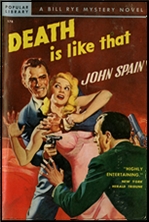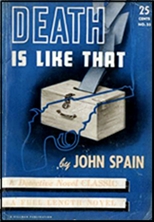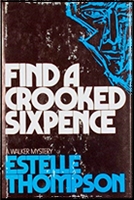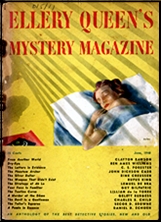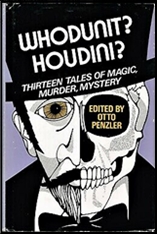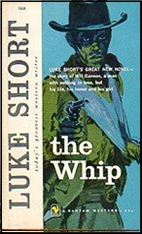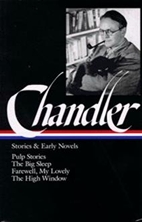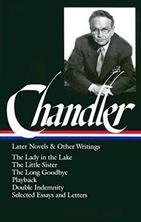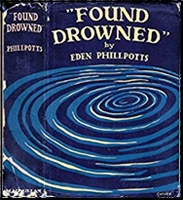REVIEWED BY DAVID VINEYARD:
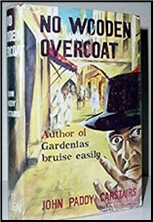
JOHN PADDY CARSTAIRS – No Wooden Overcoat. Garway Trenton #2. W. H. Allen, UK, hardcover, 1959. No US edition.
My fate seemed a foregone conclusion of torture and finally death, buried in the deep six in a land that wasn’t even my own — and perhaps not even a wooden overcoat.
Gar(way) Trenton, ex-Royal Navy pilot and successful novelist, is having a low point, all at sixes and sevens after a previous adventure that left him having nightmares of nearly being killed (I awoke screaming. I was dreaming I was back in the South of France and reliving my “holiday†there), but when a mysterious phone call from a man called Mr. Shadrach offers adventure he can’t resist.
“This is a Mister Shadrach here,†a voice said.
“Abednego here,†I retorted.
Mr. Shadrach represents Interpol (yes, this is the kind of book that thinks Interpol is an actual international police organization with agents and international authority — somebody watched too many episodes of The Man From Interpol with Charles Korvin) and Otto Von Scheidner, the Interpol agent Trenton met in his first adventure (Gardenias Bruise Easily). It seems there is a deadly drug smuggling ring in Tangier and every available Interpol agent has been blown.
Would Trenton like to help out, all expenses paid, him, with his Mauser Horace, his Aston Martin, and his buddy from his last adventure London Broker Ginger Bier (yes, Ginger Bier — it’s that kind of book)?
What two-fisted all-British kind of hero could pass up that kind of adventure?
Not this one, though he probably should have.
Once he and his Aston Martin arrive in Tangier things go steadily downhill. The Mr. Taghore from Interpol he is supposed to meet turns out to be one of the bad guys and the real Interpol agent set to meet him at the airport Captain Captain Edward Cuffley-Evans has been kidnapped by the opposition.
As the real Mr. Taghore explains Trenton has been blown, his mission over before he begins.
With twenty four hours to kill Trenton decides to visit a club where Ginger knows a girl who is performing, Fern La Verne — an arresting looking girl in her late twenties, pale and thin with large almond shaped eyes, and long fair hair. Fern (it’s a stage name, and yes, Carstairs fails basic Chandler/Fleming naming of exotic names) is tough but tender, but is she fair or foul is the question.
Fortunately he is better at character than names.
“…in life one spends a lot of time wishing for miracles.â€
“Ever get any?†She inquired.
“Oh, yes I’m a firm believer in miracles.â€
“I wish I was.â€
After a passionate kiss, he finds himself back in his hotel room where a tall stunning English blonde is waiting for him. Clare, wife of Captain Cuffley-Evans, who wants his help getting her husband back. She’s hiding something, but he isn’t sure what, but she is very beautiful and Trenton has decided to stay on and try to help not the least because he is attracted however guiltily to a married woman.
John Paddy Carstairs was a novelist, a successful artist, screenwriter, and perhaps best known as a director (1933-1970: The Saint in London, Sleeping Car to Trieste, several hit Norman Wisdom comedies, and two episodes of The Saint television series). With Gardenias Bruise Easily he turned to thriller writing with his hero Garway Trenton,who falls somewhere between James Bond and a Peter Cheyney protagonist with occasional forays into Bulldog Drummond.
Carstairs was also handsome, a musician, and had family in the film business (Anthony Nelson Keys) the lucky talented S.O.B..
In short order Trenton finds himself kidnapped by the opposition led by the sadistic Paul Garon (It was a handsome dissipated face, arrogant and cynical, and I could picture women being positively anxious for him to be contemptuous of them) and his smoother partner, the sinister mouthed Dragadore, the false Mr. Taghore who met with Trenton earlier.
Turns out they kidnapped Cuffley-Evans to have his wife assassinate Mr. Taghore for them, but now they have Trenton he seems a much better choice.
To conceive a plot on a way in which to kill a man — a man well protected — by remote control wasn’t easy. Then too I’d got to think up an antidote, as it were, to save him.
Two-fisted and fast with a gun, Trenton will win out in the end, but not without broken bones, knife wounds, and a few bullet holes worse for wear.
I’m divided on this one. I thoroughly enjoyed it, but whether anyone else would I can’t guess. Carstairs makes multiple faux pas as a thriller/suspense writer, but he obviously enjoys the genre, knows it pretty well, and his cinematic eye often makes this read more like a really good detailed scenario for a fun film than a novel.
Perhaps not surprising for the man who had a decent career as a director. (Other than Charteris, Carstairs is the only talent involved with both RKO’s The Saint series and the ITV version).
That cinematic reference is not a knock. It’s the quality that makes the book fun. I’ll be looking for Gardenias Bruise Easily, and wish there were more adventures of Gar Trenton. He’s a bit of a block head at times, talks a bit too much, but he’s a colorful guy and his creator nails the glamour, sex and violence, action, tongue in cheek, and exotic locales of the genre like an old pro.
Had he come along a few years later at the height of the Bond craze, Trenton might have had legs. As it is, he falls in that awkward era between Peter Cheyney and Ian Fleming where the British thriller was transitioning from the older Buchan/Edgar Wallace style to a more Americanized feel.
All I can say is I would read more of these if they were available and ultimately what more can you say about a thriller writer and series.
___
Editorial Note: You’re in luck, David. See below. (But how easily these may be found is another matter.)
The Garway Trenton series —
Gardenias Bruise Easily (n.) Allen 1958 [France]
No Wooden Overcoat (n.) Allen 1959 [Tangier]
Touch a French Pom-Pom (n.) Allen 1960 [France]
Pardon My Gun (n.) Allen 1962 [Corsica]
The Concrete Kimono (n.) Allen 1965 [Africa]
A Smell of Peardrops (n.) Allen 1966 [Tangier]
No Thanks for the Shroud (n.) Allen 1967 [Los Angeles, CA]
